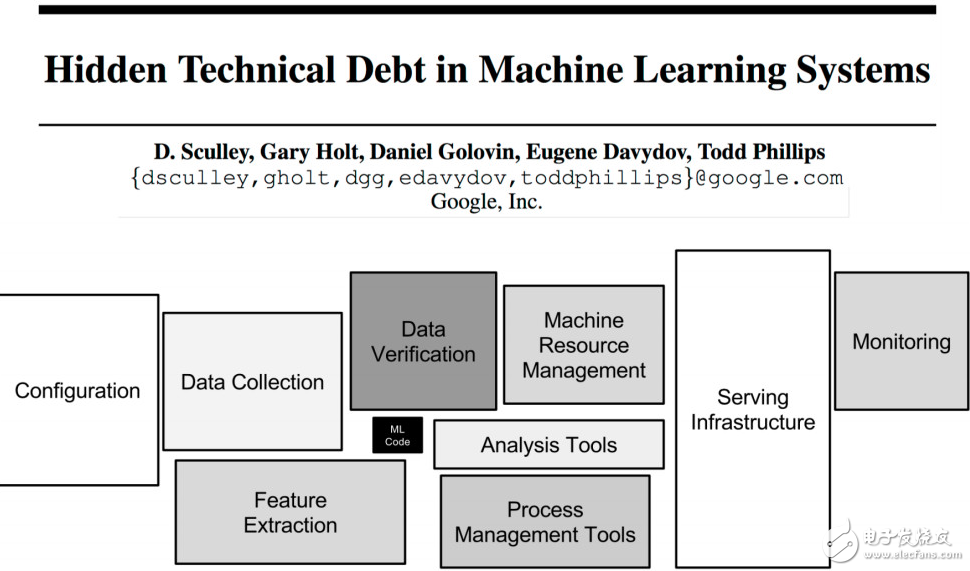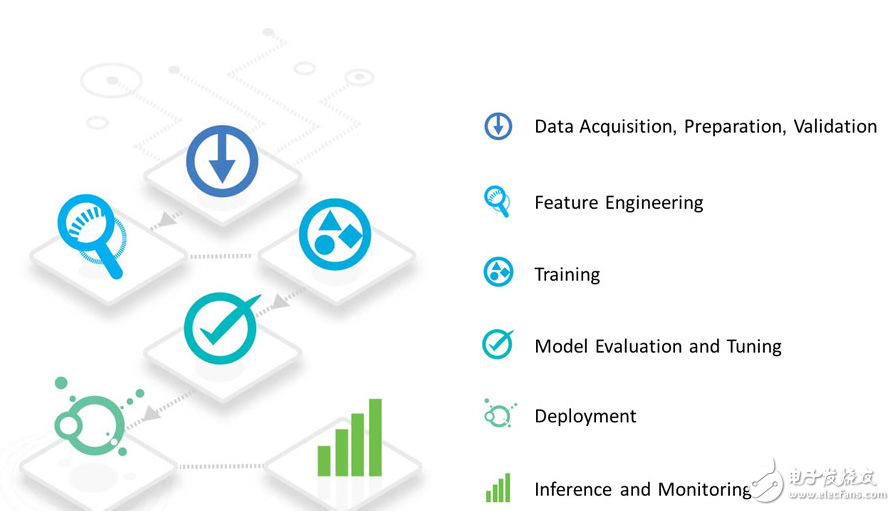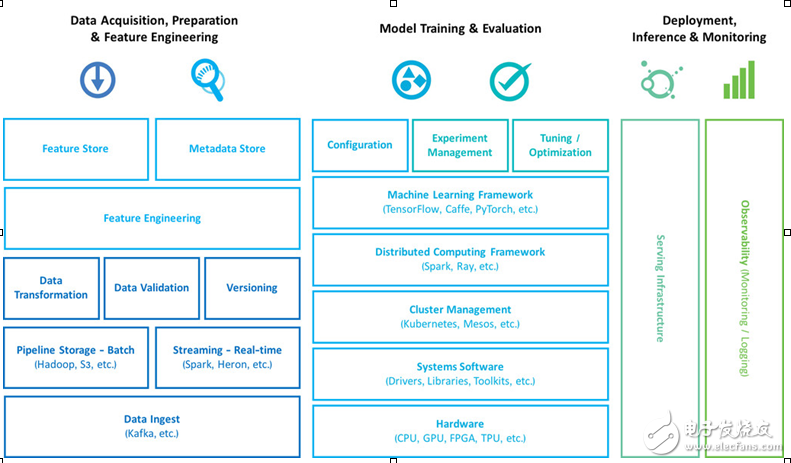The relationship between application and infrastructure should be close. It should be that you have me and I have your common development. As the network matured, we began to connect the world, from infrastructure 1.0 to infrastructure 2.0 to infrastructure 3.0, and we slowly moved toward smart systems.
The era of machine learning and artificial intelligence has arrived. The development of big data, large-capacity storage, elastic computing and various algorithms, especially in the field of deep learning, has brought about a variety of innovative applications.
In a complex strategy game like Go, the machine has outperformed humans. Applications such as image recognition and speech recognition are even more important. Voice intelligent assistants began to popularize and drive cars on the road. However, for the recent development of machine learning/artificial intelligence, many of the discussions have focused on algorithms and applications, and few have discussed the underlying infrastructure.
In the early days of computing technology, only assembly language experts, compiler experts, and operating system experts were able to develop simple applications. The current situation is very similar. Only when you get a Ph.D. in statistics or distributed systems, can you know how to develop an artificial intelligence system and deploy it on a large scale. The missing link is the abstraction tool that accelerates the development of artificial intelligence. Therefore, only the most elite engineering team has the complete ability to do this work.
On the other hand, the development of infrastructure is also lagging behind the innovation of machine learning technology. In short, the systems and tools that are the foundation of current machine learning applications are not really suitable for the evolution of future smart applications. Looking to the future, the industry needs new tools to unlock the potential of artificial intelligence, making artificial intelligence more accessible and more practical. Therefore, in the field of infrastructure entrepreneurship, providing the modules needed for intelligent system development, this will be a big gold mine in the future.
From Infrastructure 1.0 to Infrastructure 2.0The relationship between applications and infrastructure is subtle, mutually restrictive and mutually reinforcing.
The development of hardware and system software has brought a new class of applications. These applications are constantly being refined and matured, so that higher requirements are placed on the underlying resources, and the underlying infrastructure is forced to innovate. In turn, infrastructure optimization, innovation, and cost-effectiveness will also lead to disruptive applications that provide users with an unprecedented experience. A typical example is from slideshows to PPTs to various online image social platforms such as Pinterest.
At the beginning of this century, the development of the commercial Internet was based on Intel's x86 instruction set, standardized operating systems from Microsoft, relational databases from Oracle, Ethernet devices from Cisco, and network storage tools from EMC. Amazon, eBay, Yahoo, and even the original versions of Google and Facebook are based on these infrastructures. This is the “Infrastructure 1.0†of the technology industry.
However, with the gradual maturity of the network, the total number of Internet users has increased from 16 million in 1995 to more than 3 billion at the end of 2015. The application requirements for scale and performance have also increased significantly. The technology of the "client/server" era is no longer suitable for the needs of the Internet giant, both in terms of feasibility and cost performance.
As a result, Internet companies are beginning to be self-reliant. With its technical expertise and academic progress, Google, Facebook and Amazon have defined a new class of infrastructure. Such infrastructure has the following characteristics: scale scalable, programmable, usually open source, and low cost. Related technologies, including Linux, KVM, Xen, Docker, Kubernetes, Mesos, MySQL, MongoDB, Kafka, Hadoop, and Spark, define the era of cloud computing. This is also known as the "Infrastructure 2.0" of the technology industry.
At its core, this generation of technology is designed to allow the Internet to reach billions of end users and efficiently capture and store information from so many users. As a result, innovation in Infrastructure 2.0 has led to a significant increase in the amount of data. With the development of parallel computing techniques and algorithms, we have seen the development of current machine learning.
Infrastructure 3.0: Moving to Intelligent SystemsThe ultimate question in the “Infrastructure 2.0†era is: “How do we connect the world?†And the current question is more: “How do we understand the world?â€
The difference, "connection" and "cognition", can explain the key differences between artificial intelligence and previous generation software. The code's own "cognitive power" subverts the traditional programming model. In traditional applications, program logic is write-dead, while in artificial intelligence applications, the algorithm derives its logic by analyzing big data. These logics are then used for decision making and forecasting.
The result of this is the "smart" application. But in fact, the birth of such applications requires a lot of data and consumes huge computing resources. These constraints make it difficult for artificial intelligence to be generalized, thus conforming to the computational paradigm proposed by von Neumann 70 years ago. Therefore, artificial intelligence represents a fundamental new architecture that requires us to rethink infrastructure, tools, and development practices.
So far, research and innovation in the field of artificial intelligence has focused on new algorithms, model training techniques and optimization methods. In addition, only a small portion of the code in artificial intelligence systems is used for learning and forecasting, and the most troublesome part is preparing data, developing functions, and enabling distributed infrastructure to run on a large scale.

If you want to successfully develop and deploy artificial intelligence applications, you need to coordinate multiple discrete systems and design sophisticated processes. First, you need to digest the data, smear it, and tag the data. Then, in order to achieve the prediction, you must determine the appropriate characteristics. Finally, developers must train the model and validate, deploy, and optimize. The entire process can take several months, even for the most technically professional organizations.

If you want to maximize the potential of artificial intelligence, you must extract practical points from the current academic philosophy. In practice, this means new abstractions, new interfaces, systems, and tools are needed to help developers develop and deploy smart applications more easily.
This is probably not a gradual change, but a subversive, fundamental change. Both the design method and the development method will change dramatically.
Correspondingly, at every level of the system, we are seeing new platforms and tools appearing, trying to optimize the artificial intelligence development paradigm. There are many opportunities:
1. Integrating multiple compute cores, dedicated hardware supporting high bandwidth storage is emerging. These chips are optimized for high-concurrency numerical calculations and are more suitable for fast, low-precision, floating-point computing tasks required by neural networks.
2. The system software will increase efficiency for hardware configuration and even maximize the capabilities of each transistor.
3. Whether used for training or reasoning, distributed computing frameworks can effectively scale model operations across multiple nodes.
4. Data and metadata management systems bring a reliable, unified, and replicable data pool that provides and manages large data sets for training and forecasting.
5. Based on real-time data and content, the ultra-low latency service infrastructure allows machines to perform intelligent operations quickly.
6. Model expression, Q&A, debugging and monitoring tools help to monitor, debug and optimize models and applications on a large scale.
7. The end-to-end platform encapsulates and abstracts the entire artificial intelligence workflow, simplifying the complexity faced by terminal developers. Examples of this include Uber's Michelangelo and Facebook's FBLearner, and those already commercialized include Determined AI.
In the past 10 years, we have seen the rise of “cloud computing species†in terms of technology. Similarly, in the coming years, we will see that a new ecosystem of infrastructure and tools will be born around machine learning and artificial intelligence.

The collection of these innovations is "Infrastructure 3.0", which will also fully release the ability of artificial intelligence to provide modular tools for the construction of intelligent systems. We will see new projects and platforms, as well as the rise of new companies.
The ultra-thin precision cutting of the Anti-Peep Screen Protector means that you can enjoy a perfect touch screen experience without allowing anything on the screen to be peeped. Whether you place your phone horizontally or vertically, Privacy Screen Protector can protect your personal Information and sensitive information are protected from harm by strangers. People around you cannot see the contents of your phone, so your details are safe.
The use of soft TPU material can really cover the entire screen.
With self-healing function, it can automatically repair bubbles and scratches within 24 hours.
The 0.14mm Ultra-Thin Protective Film can maintain the sensitivity of the touch screen to accurately respond to your touch.
The oleophobic and waterproof coating prevents fingerprints, oil stains and other substances from adhering to it and keeps the screen clean.
If you want to know more about Privacy Screen Protector products, please click Product Details to view the parameters, models, pictures, prices and other information about Privacy Screen Protector products.
Whether you are a group or an individual, we will try our best to provide you with accurate and comprehensive information about Privacy Screen Protector!
Anti-Spy Hydrogel Screen Protector, Privacy Protection Film, Protection Film, Privacy Film, Privacy Screen Protective Film, Soft Film
Shenzhen Jianjiantong Technology Co., Ltd. , https://www.jjttpucuttingplotter.com